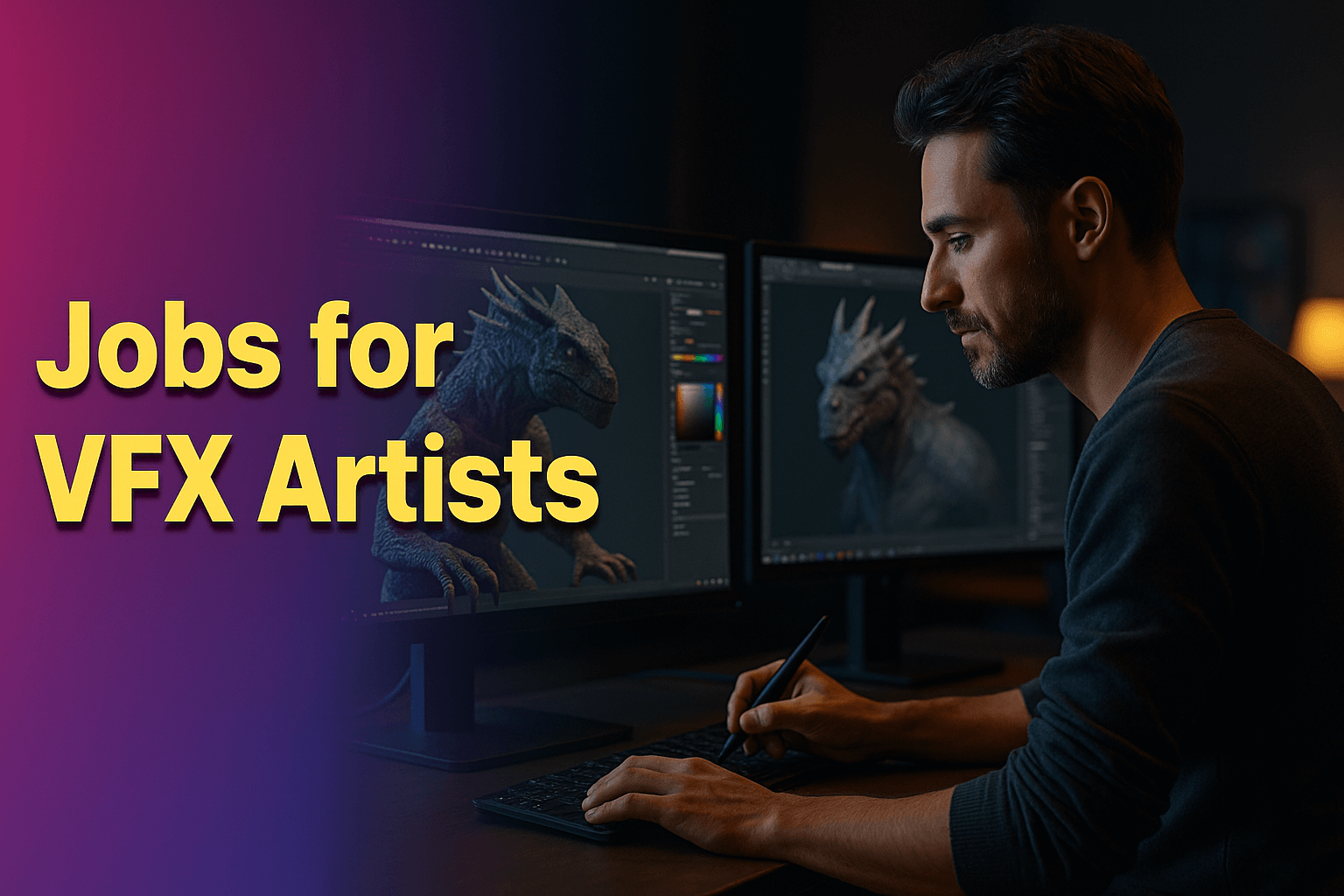Jobs for VFX Artist: A Strategic Career Guide

Introduction
In my analysis of the global Media & Entertainment supply chain, a critical observation emerges: the term “VFX artist” is often a broad generalization for a highly specialized and diverse set of roles.
For M&E executives, producers, and recruiters, understanding the nuanced career paths within the visual effects industry is not just about hiring; it’s about building a project team with the right expertise, managing a budget effectively, and navigating a global talent pool.
The challenge lies in the sheer fragmentation of this market. How do you find a specific compositing artist with a proven track record on a particular type of project, or a technical director specializing in fluid dynamics, when the data is siloed and based on outdated résumés?
Key Takeaways
| Core Challenge | The VFX industry’s talent pool is fragmented, making it difficult for M&E executives to efficiently discover and vet specific specialists for jobs for a VFX artist. |
| Strategic Solution | A centralized, data-driven platform is required to provide real-time, verified intelligence on VFX talent, their credits, and their collaborative history. |
| Vitrina’s Role | Vitrina serves as a single source of truth for the entertainment supply chain, enabling studios, producers, and recruiters to discover, analyze, and connect with vetted VFX professionals globally. |
The VFX Ecosystem: A Breakdown of Key Roles for a VFX Artist
The visual effects pipeline is a complex, multi-stage process, and each stage requires a different skill set. While a generalist might be a jack-of-all-trades, a major studio production relies on highly specialized roles. For an executive looking to staff a new project, understanding these distinctions is crucial for both creative and financial success. The following are some of the foundational jobs for a VFX artist:
- Compositing Artist: This is arguably one of the most critical roles. The compositor is responsible for seamlessly blending different visual elements—live-action footage, CGI, and matte paintings—into a single, cohesive shot. A successful compositor requires a keen eye for color, light, and perspective to ensure the final image is believable.
- 3D Modeler: The modeler is the digital sculptor. They create the 3D models of characters, props, and environments based on concept art. Their work is the foundation for almost all subsequent 3D-based roles.
- FX Artist (Effects Technical Director): An FX artist specializes in creating procedural or simulated effects like fire, smoke, water, destruction, and particle effects. This role often requires a strong understanding of physics and scripting to produce realistic, dynamic simulations.
- Roto and Paint Artist: This is a foundational, yet highly meticulous role. Roto artists create mattes or masks to separate elements from a shot, a process often used in compositing. Paint artists clean up footage, removing wires, rigs, or other unwanted elements.
Each of these roles represents a specific talent niche. For a studio executive, the challenge is that an artist’s title on a résumé may not fully convey their specialization or their specific contributions to past projects. A generalized search for “VFX artist” can yield thousands of unqualified candidates, wasting valuable time and resources.
Beyond the Artist: Specialist and Technical Jobs for a VFX Artist
While the roles above are artist-focused, a successful VFX pipeline is also supported by a team of highly technical and supervisory professionals. These are the individuals who manage the data, the workflows, and the creative vision. For a senior producer or a line producer, finding these specific experts is a strategic priority:
- VFX Supervisor: This is the creative and technical head of the VFX department. The supervisor works with the director from pre-production through post-production to design and execute the visual effects. A good VFX supervisor has a strong creative eye and a deep understanding of the entire pipeline.
- Pipeline Technical Director (TD): TDs are the backbone of the technical workflow. They are programmers and problem-solvers who create and maintain the tools and systems that allow artists to work efficiently. A pipeline TD ensures that data flows smoothly from one department to the next without error.
- Matchmove Artist: A matchmove artist’s job is to replicate the live-action camera’s movement in a 3D environment. This allows CGI elements to be rendered from the exact same perspective and seamlessly integrated into the shot.
- Look Development Artist: These specialists are responsible for the textures, shaders, and materials of 3D models. Their goal is to ensure that digital assets—whether a creature’s skin or a spaceship’s hull—look realistic and interact with light correctly.
The global nature of the VFX industry means that these specialized roles are often filled by freelancers or by vendors located in different parts of the world. For a studio executive, this creates a significant visibility problem. Without a centralized, verifiable database, it is nearly impossible to track an individual’s specific credits and past collaborations across various studios and projects.
Market Trends and the Business Imperative for Jobs for a VFX Artist
The demand for VFX talent is growing at an accelerated pace, driven by several key market trends. According to a 2024 report by IMARC Group, the global visual effects market was valued at USD 10.70 billion in 2024 and is projected to reach USD 18.75 billion by 2033. This growth is fueled by:
- The Rise of Streaming: Platforms like Netflix, Disney+, and HBO Max are producing a high volume of original, VFX-heavy series, creating a continuous demand for talent.
- Gaming and Immersive Experiences: The gaming industry is a major employer of VFX artists, and the rapid expansion of AR/VR technology is creating new, high-demand roles.
- Global Production: Studios are increasingly producing content in international markets, which opens up new talent pools but also complicates the process of discovery and verification.
For an M&E executive, this expanding market presents a dual challenge: the talent pool is growing, but so is the complexity of navigating it. The old methods of networking at conferences or relying on word-of-mouth are no longer sufficient to secure the best talent in a timely manner. The business imperative is clear: you need a strategic, data-driven approach to talent acquisition to stay competitive.
For more on the market, read our analysis on The Future of Media Production in the Digital Age. Variety, a leading industry publication, frequently reports on the evolving landscape of media production and the increasing role of technology.
The Challenge of Data Fragmentation for Jobs for a VFX Artist
The single greatest obstacle for a producer or studio executive trying to fill key jobs for a VFX artist is data fragmentation.
Information about a professional’s career is scattered across a multitude of sources: personal websites, IMDb pages, LinkedIn profiles, and studio project databases. This siloed data makes it difficult to get a holistic, verified view of a candidate’s experience and contributions.
My analysis confirms that this fragmentation leads to several core pain points:
- Inefficient Vetting: Manual verification of credits and collaboration history is time-consuming and prone to error. It is difficult to confirm a candidate’s specific role on a project or their precise skill set without a centralized source.
- Limited Discovery: Executives are often restricted to their immediate networks or a handful of well-known studios. This limits their access to emerging talent or highly specialized professionals in other markets.
- Delayed Hiring: The time it takes to find and vet the right talent can delay production, leading to increased costs and missed deadlines.
Vitrina: Connecting the Dots for Executives in the VFX Job Market
The strategic solution to this fragmentation is a platform that centralizes and verifies industry data with algorithmic precision. Vitrina’s core value proposition is to serve as the single source of truth for the entertainment supply chain. It addresses the pain points I’ve identified by providing a comprehensive, interconnected database of projects, companies, and people.
For an executive, Vitrina provides a solution to the talent acquisition problem. You can search for a “compositing artist” and filter results by their credits on specific films, studios they’ve worked for, and even their location. The platform’s verified data allows you to see not just where a person has worked, but with whom they’ve collaborated.
This level of granularity is essential for making informed hiring decisions. Vitrina’s proprietary algorithm processes over 500 million data points daily, from trade publications and company registries to festival submissions and production listings. This means that its users can access verified contact details for over 3 million professionals, enabling direct outreach and streamlining the hiring process.
Vitrina’s platform provides a strategic advantage by transforming talent scouting from a manual, guesswork-based process into a data-driven, efficient workflow. For a deeper dive into how Vitrina tracks projects and talent, see our article on How Vitrina Tracks Projects and Talent Globally.
Conclusion
The visual effects industry is a powerhouse of creativity and technology, with a diverse ecosystem of specialized jobs for a VFX artist. For the executive, the challenge is not a lack of talent but a lack of visibility and structured data on that talent. My analysis concludes that the industry is at an inflection point. Executives who continue to rely on traditional, manual methods for talent acquisition will find themselves at a growing disadvantage.
The future of deal-making, co-production, and talent scouting will be defined by who has the most accurate and timely data. By leveraging platforms like Vitrina, executives can move beyond passive observation to an active, data-informed strategy for building the best creative and technical teams for their projects.
Frequently Asked Questions
A VFX artist needs a mix of technical and creative skills. Technical skills include proficiency in industry-standard software like Maya, Houdini, Nuke, and After Effects. Creative skills include a strong artistic eye, attention to detail, and a solid understanding of storytelling, composition, and physics.
The job market for VFX artists is projected to grow significantly. This demand is driven by the rise of streaming platforms, the booming video game industry, and the increasing use of visual effects in advertising. However, it remains a competitive industry that requires continuous learning and skill development to stay relevant.















































